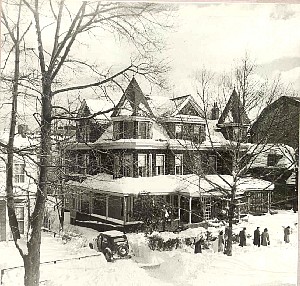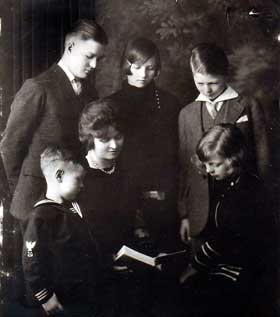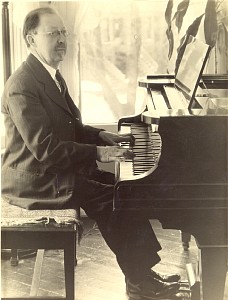My early years in Brooklyn, New York, 1920-1928
Living Arrangements
Here’s the setting, I lived in this period with my father, mother, two older brothers, two older sisters (sandwiched in age between my brothers) and a live-in maid, whose identity changed from time to time but was always Norwegian, our family’s heritage, We lived in a high-ceilinged, 3-story shingled house (weathered, not painted -- which is the sensible thing) at 357 Ovington Avenue in Brooklyn, New York. The house was located between third and fourth avenues and between 69th Street and 71st Street, in Bay Ridge. [Ed note: looking on Google maps that address is no longer and there are a series of red brick medical buildings at that location)

The house shared a common wall with its mirror twin, occupied by a family named the "Hansons," We never saw nor heard the Hansons. But they must have heard us, because the whole second floor of our house and part of the first was given over to " Munson Institute of Music." Pianos were bellowing forth from three "studios" on the second floor up to six hours a day starting at noon. Longer on Saturdays. But never on Sundays.
My dear sister "Wiggles" (not really her name but given to her by Alex, oldest of the children, because she resembled a camp counselor with a similar name), nearest to me in age, was puzzled by the economics of the music school, "Does the money roll out of the piano when pupils play it?" she asked.
More about the house. It had a long hall running from the front of the house to the rear on each of the three floors, foreshortened slightly at each end on the second and third floors. Opening off the hall on the first floor -- from front to back -- was the living room (used as a reception room for the music school), a dining room, a pantry and a kitchen. In the same order on the second floor were a large studio (my father’s with his Steinway grand piano fitted into an alcove provided by the Frank Lloyd Wright-like tower on the front corner of the house on the side away from the Hansons). Then came two studios. There were commodious closets separating the studios from each other, used mostly to store quantities of sheet music. A bathroom was at the end of the hall in the rear.
Since the hall was next to the common wall shared with the Hansons it had no windows. It was always dark. Add to this the fact that the interior was paneled on the first two floors in dark oak. Pretty gloomy. Oh yes, before my time they must have used the old gas lighting fixtures that still stuck out of the wall in the hall although no longer used. In the hall on the second floor there was an old fashioned telephone on a small shelf It was a two-handed one. One hand to hold the base and mouth piece; the other to hold the earpiece to your ear.
We had a coal furnace, which generated a quantity of ash that had to be deposited in ash cans and placed outside to be picked up by the "Ash Man," who came in an impressive large truck. Dad had to "bank" the furnace at bedtime so the fire would not go out overnight and revive it at the crack of dawn by opening the draft and shoveling more coal on to the fire.
We also had a "Garbage Man," who removed our accumulated garbage, and an "Ice Man," who regularly delivered a large chunk of ice which he carried in a burlap bag slung over his shoulder. He would deposit it noisily into our icebox which was on a narrow porch outside the kitchen. It seemed like a dreadful way to carry ice around. Later in life, I was to see some men cutting blocks of ice out of a frozen lake and storing them in an "ice house" that had some primitive insulation - thick walls and partly sunk into the ground like a Long Island potato barn. I believe they used straw to provide separation between the large blocks of ice.
Of course we had no television, hi-fi systems or computers. We eventually did have a large piece of furniture that housed a hand-operated phonograph. It had a hinged top which when opened provided a 78 rpm turntable and a movable arm with a needle to track the groove in the shellac records. How this produced a sound loud enough to hear, I still do not know. There was a unit that looked like a giant earphone that deaf people used to use which apparently amplified and directed the sound that came from the pressure of the needle in the groove.
We rarely used this appliance. I can remember two record albums that we had, One was a collection of marches used to accompany morning exercises called "The Daily Dozen." The other was Dvorak’s New World Symphony, the slow movement of which was played at Mother’s funeral service in 1929. I also remember being instructed by Mother to destroy publicly some jazz records that Alex brought home and were considered "sinful."
The kitchen was sunny and simple. It overlooked the back yard and part of the driveway. There was a gas stove with four burners and one oven, all on four legs. A plain table with four chairs was by the window. I can still see Sally Reimond sitting at that table. She was Mother’s best friend and loved to drop by for coffee and cakes. She was a jolly person and got Mother to join in many good laughs.
I presume we had a hot water heater in the basement, connected to the furnace. We always seemed to have enough hot water coming out of the faucets. In addition we had a dirty coal bin in the basement, an old pool table and a workshop for Alex (my oldest brother). It had a dank smell.
Activities

Most of the activities I remember were family oriented. We all went to the 46th Street Lutheran Church every Sunday. From time to time the church would give a prize for the family who appeared with the most members -- a bible. We won this prize a number of times.
The children all lived and played on the third floor or outdoors, except for meals and evenings. But we had to go down to the bathroom on the second floor for our baths (no shower). Mother would occasionally have to leave me alone in the tub and told me to say "no mittens" if anyone came to the door. Why those words were so magical I had no idea.
The girls played with dolls and I played with blocks and soldiers. Every year, Alex -- in anticipation of Christmas, would make a new layout for our electric trains in the cellar. Then, on Christmas Day I was allowed to see his latest creation I remember one in particular. He used an old pool table for most of the track but had some very realistic trestle bridges that he made himself to connect the center section with a track that ran along the wall for a considerable length and then returned to the center table. The trains were much larger than those that came later: "Standard" as compared to "0 Gauge" and even smaller which came years later. The trains we had were most impressive when they raced around that layout.
We spent a fair amount of time visiting relatives. Mother used to take me on the Long Island Railroad to visit her mother (Mor-mor) and father (Da-da) in West Hempstead. Dada had a farm out there with real sheep, which Henry (my other brother) used to like to ride with his cousin Burton. Burton was a year or so younger than Henry and lived with his parents (Aunt Helen and Uncle Oscar) in Flatbush. We also visited them from time to time.
Curiously enough, I don’t remember taking pleasure drives in our car, although it was readily available in the detached garage we had in the back of the house. We used it to visit relatives and to make the annual trek to Cragsmoor, the family summer place. I can remember a large Studebaker Touring Car with open sides. In those days you used a crank which you connected to the end of a shaft in the front of the car to turn the engine over. My job, on occasion, was to sit in the driver’s seat, turn up the gas and turn down the spark as soon as the engine started up. Sometimes it took a bit of cranking to make that happen. In case of rain, we had some strips called "isinglass" that we would snap in place to keep out the rain while preserving some visibility.
People
My recollections of the people around me in those years is still vivid in my mind. The dominant character in this play was my mother, who (I’m told) idolized me. She was loved and adored by all of us with an intensity that is difficult to recreate in words, an intensity that may be magnified by her early death in an automobile accident. She not only ran the household. She was the creative and energetic manager of the music school. She organized some social clubs around different musicians in which people would meet together. Years later I was told that the Bach Club had continued to exist for a long time after all its members had graduated from the Munson Institute. My father once said to me, "Whenever I saw a certain look in Mother’s eye, I knew I would have to do something 1 wasn’t too keen on doing." One of those somethings was to make some recordings for the Victor Company, then a big name in recorded music.
She was religious to a fault. We always had to go to church on Sundays and we couldn’t play cards or use scissors on the Lord’s day. Smoking and drinking alcoholic beverages were major sins. She spent some part of every day at her "devotions," kneeling beside her bed and praying to God. I once asked her what she said to God and she answered "mostly to take care of you and all my loved ones."
She gave herself unselfishly to others. Alex once told me that he was driving Mother along fourth avenue when she said "stop the car." which he did. She then went into a small retail store and spent ten minutes looking at merchandise. She came out without having bought anything, then explained to Alex that she just wanted to stop a fight that she had seen in progress between the man and woman who apparently were the proprietors.
 Dad was a talented musician but a poor businessman. As long as Mother was in charge, the Munson Institute of Music thrived. Without her, and assisted by the Great Depression, it barely survived. The bank foreclosed on the house we had moved to in Garden City, Long Island and we had to move into a small apartment on 223 Seventh Street there. Dad was a kind, caring father who left the children’s upbringing to my mother. He would dutifully deliver spankings when she asked him to. But his heart was never in them.
Dad was a talented musician but a poor businessman. As long as Mother was in charge, the Munson Institute of Music thrived. Without her, and assisted by the Great Depression, it barely survived. The bank foreclosed on the house we had moved to in Garden City, Long Island and we had to move into a small apartment on 223 Seventh Street there. Dad was a kind, caring father who left the children’s upbringing to my mother. He would dutifully deliver spankings when she asked him to. But his heart was never in them.
Alex was my "big brother." We were 12 years apart but I enjoyed keeping him company while he worked at his workbench in the cellar. During these years in Brooklyn he was going through the difficult teens. Always full of spirit (and mischief) he must have bridled under the tight controls that Mother exercised. We were still living in Brooklyn, I believe, when he went away to college in Bethlehem, Pennsylvania -- Lehigh. Alex suddenly found himself in an environment with new freedom. He had already taken up smoking (and developed a smoker’s cough) and now he took up drinking. He ended up being kicked out of Lehigh for having stolen some wooden Indians from the front of a cigar store in Bethlehem .
Marian (the second oldest) would later become a second mother to me after Mother died, and even before then was occasionally put in charge of me. But mostly, to me, she was one of two sisters. Four years apart in age, the two were good company for each other. They both attended Shore Road Academy, a private day school that overlooked New York Harbor.
Henry, my other brother, who was two years younger than Marian and two years older than "Wiggles" was a beautiful child. So much so that Marian was jealous of him and asked Mother why every one singled him out for praise when the two were taken out together. Henry was a dreamer. His teachers reported he spent large amounts of time looking out the window dreaming. He once told his siblings that he would "join the kings" when he grew up, which in a sense he succeeded in doing. He later became very much in demand, an unusually attractive bachelor living in a chic apartment at 57 East 72nd Street in Manhattan.
Previous page: Recollections of Grandpa Larry (L.S.Munson) Next page: My summers in Cragsmoor, New York, 1920-1935
